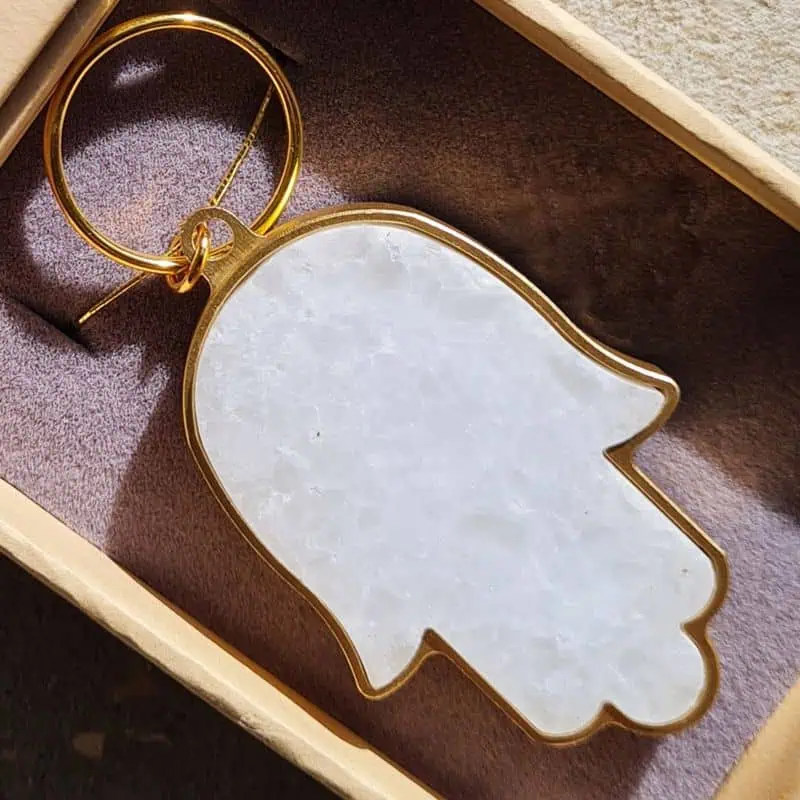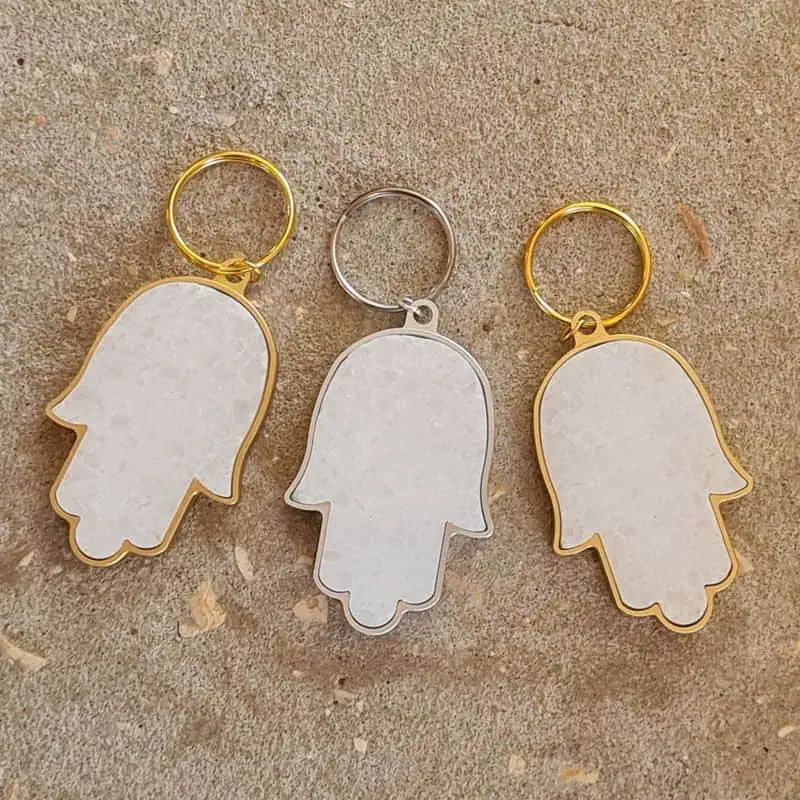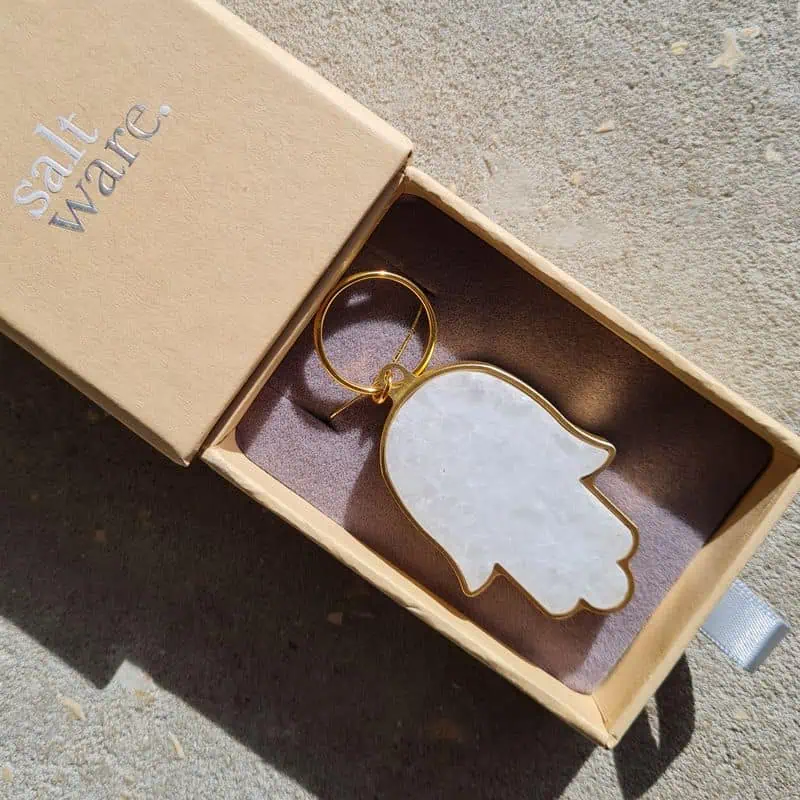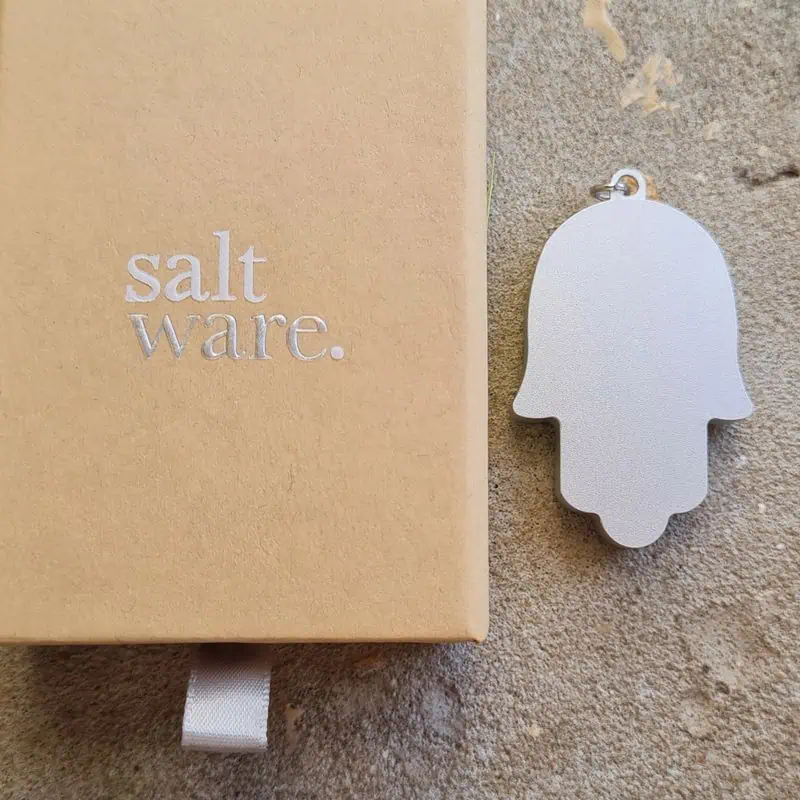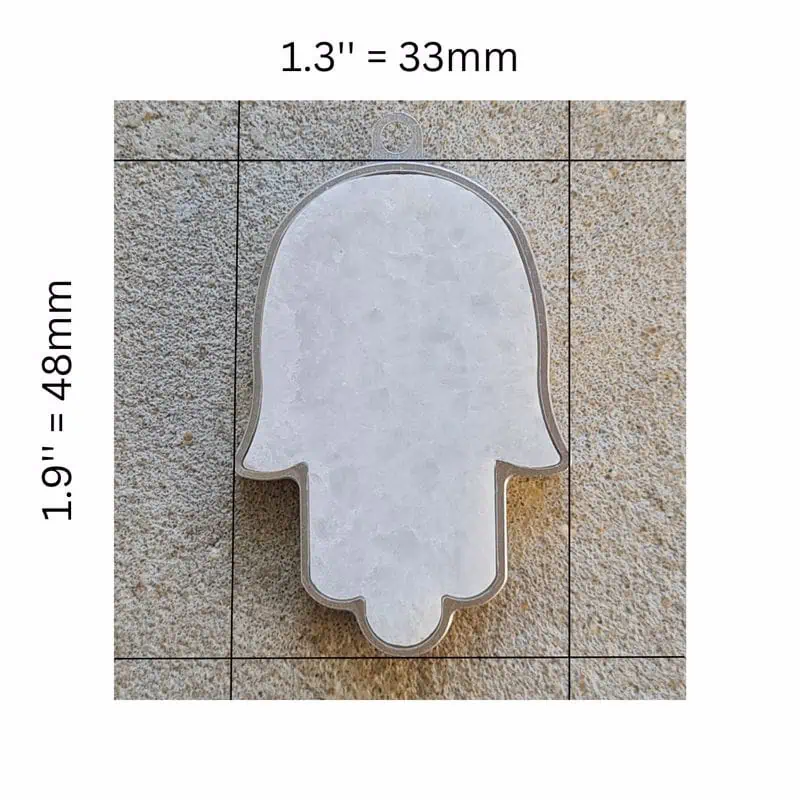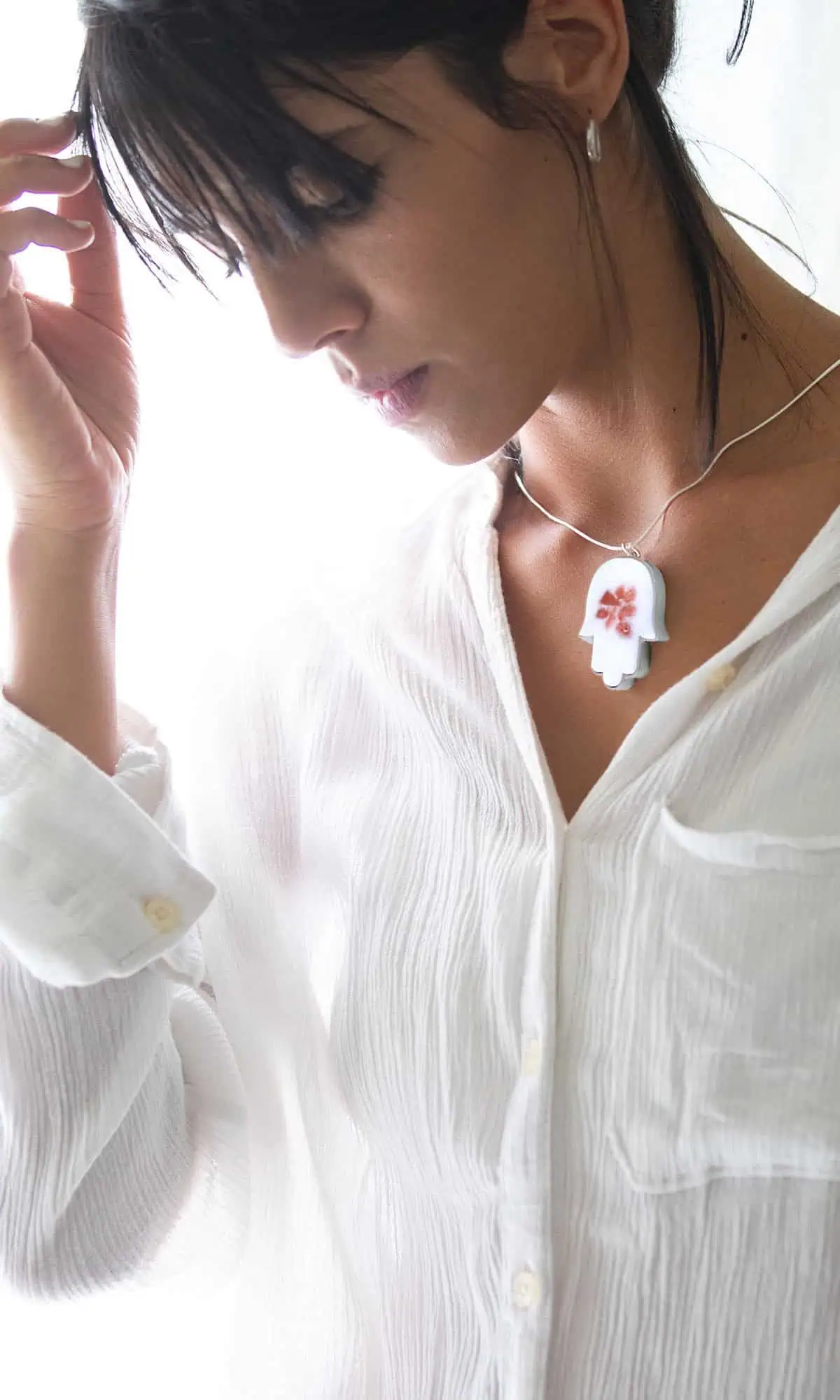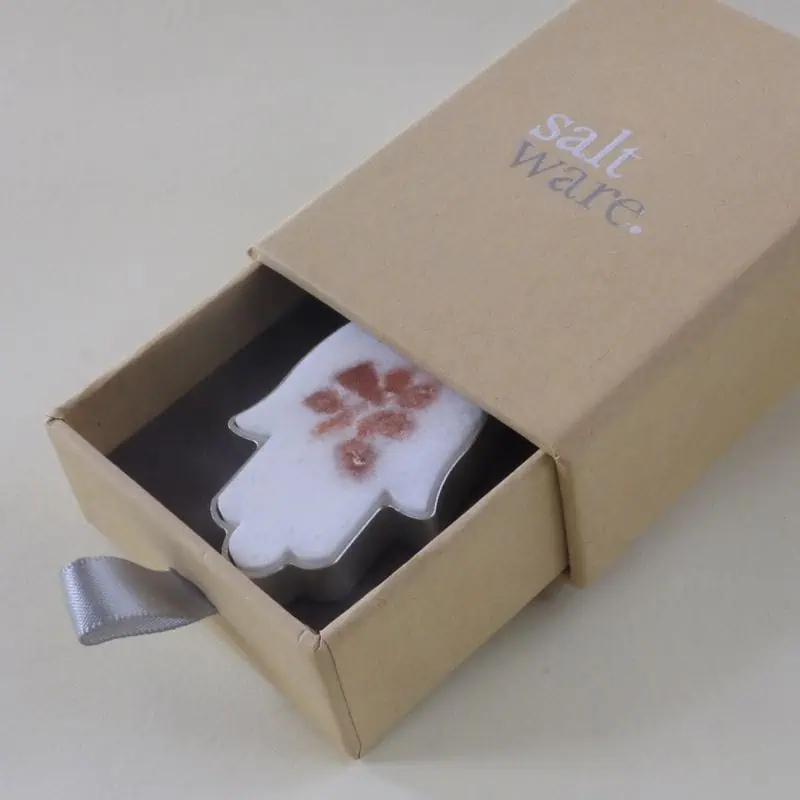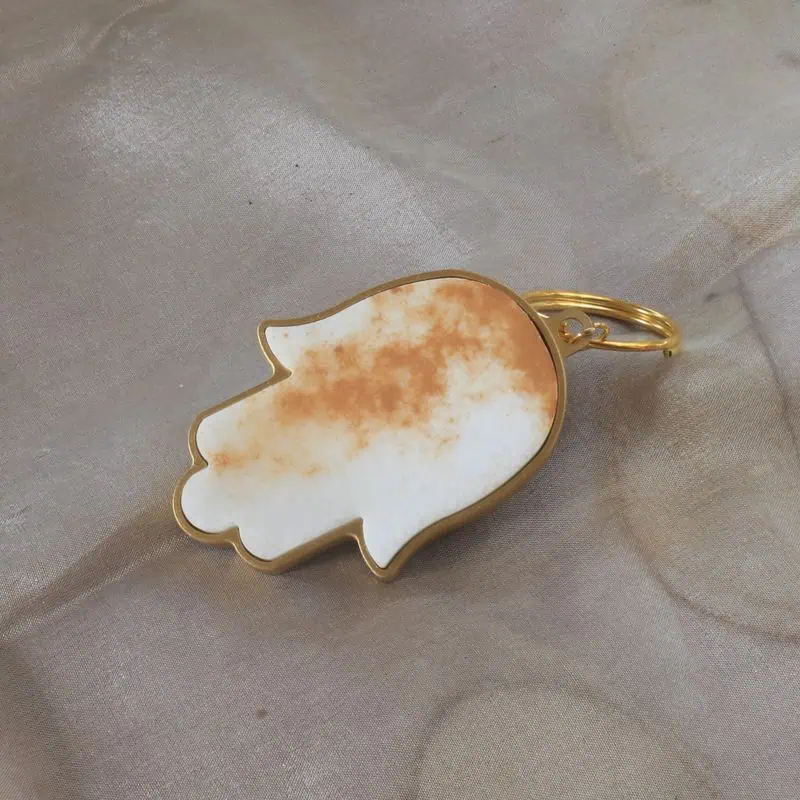Hamsa Keychain Pure White
SHOMERA
Shomera Hebrew -‘שוֹמֵרָה’ – keeper or a structure designed for protection
Salt is a symbol for blessing- carring a tiny sack of salt is considered
in many cultures as a protective amulet.
Add this exclusive hamsa to your keychain and you’ll have
a piece of the HolyLand to take with you wherever you go.
$60
$60
PURE WHITE is designed of small chunks of SALT from the Holy Land
This design may come with a gold or silver seat for your choice.
Each Hamsa is uniquely handmade and therefore can differ slightly from each other.
Height: 1.9” (48mm)
Width: 1.3” (33mm)
Depth: 0.3” (8mm)
Box size: 2.4 x 3.1 x 1.2” (6 x 8 x 3cm)
Ring for keychain
Exclusive recycled paper box with an embossed silver white SALTWARE logo.
The box includes an inner velvet cushion for safe keeping and a silver ribbon.
Shipping fees according to parcel value
USA ,CANDA, EU
| parcel value | Standard (ECO IS POST) | FedEx Economy | FedEx Priority |
|---|---|---|---|
| Delivery times | 14-21 Business days | 7-15 Business days | 3-5 Business days |
| UP to 70$ | 12$ | 25$ | 35$ |
| 71-150$ | 20$ | 30$ | 40$ |
| 151-350$ | 30$ | 40$ | 50$ |
| Above 350$ | free | 50$ | 60$ |
DOMESTIC (ISRAEL)
| parcel value | IS Post registered | Express (Door to Door) |
|---|---|---|
| Delivery Times | 3 Business Days | |
| UP to 70$ | 7$ | 20$ |
| 71-150$ | 7$ | 20$ |
| 151-350$ | free | 20$ |
| Above 350$ | free | 20$ |
Rest of the World
| parcel value | IS Post ECO | FedEX Priority |
|---|---|---|
| Delivery Times | 14-21 Business Days | 3-5 Business Days |
| UP to 70$ | 15$ | 35$ |
| 71-150$ | 30$ | 40$ |
| 151-350$ | 40$ | 60$ |
| Above 350$ | Free | 70$ |
Simply wipe the pendant with a damp cloth.
Do not put it the pendant unde running water.
Not suitable for tropical climate(above 75%) use.
A Perfect Gift
Add this unique Hamsa to your keychain and you’ll have a piece of the HolyLand to take with you wherever you go.
What is the Meaning of Hamsa?
The Hamsa Hand is a palm shaped amulet, found throughout the Middle East and northern Africa, also known as a good luck charm, believed to confer protection upon its possessor and brings good luck, fertility and good health.
When the evil eye is added to the Hamsa ut is believed to protect from bad luck or the evil-eye with the most common being envious glares from those with ill intentions.
The Hamsa originated in the Middle East and is used in jewelry, paintings and tatoos. In fact, although the differences are sometimes subtle, each is created for a different purpose: a charm is worn to attract good luck; an amulet provides protection from danger; and a talisman is used to attract a particular benefit to its owner.
The Hamsa Hand in Judaism
The Hamsa hand symbol was adopted by the Sephardic Jewish community in Spain and North Africa during the middle ages. In the Jewish faith, the hamsa represents the hand of and named it the Hand of Miriam after the virtuous sister of Moses and Aaron.
Hamsa is also the Hebrew word for five (hamesh in Hebrew), the fifth letter of the Hebrew alphabet.
While some believe this represents the five fingers on the talisman, others associated it with the number five to represent the five books of the Torah: Genesis, Exodus, Leviticus, Numbers and Deuteronomy.
It also symbolises, “Hay”, which represents one of God’s holy names, and further reminds Jews to use their five senses when praising God.
Hamsa Jewelry The Hamsa today is popular as a protective charm in Middle Eastern, Far Eastern and Western cultures, and is incorporated into jewellery, wall hangings, key chains, baby carriages and other jewellery and decorative household elements. The Hamsa appears in two forms: stylized with two symmetrical thumbs and asymmetrical, with a clearly defined thumb and pinkie finger. Either form may be displayed with the fingers pointing up or down. The centre of the hand often contains further symbols, especially that of an eye, however different cultures may fill the hand with images relevant to them. Most Hamsa jewellery designs are made of silver, gold or other metals.
Hamsa as a Symbol of Human Unity
The Hamsa is in the process of transcending its origins of being a talisman that is thought to have protective qualities to become a gesture of hope for peace in the Middle East. Many Jews and Arabs wear and decorate the entrance to the home with the Hamsa to demonstrate the common ground shared by them, the common source from which their religions spring and to symbolise the common goal of peace in the region.
YOU MAY ALSO LIKE
Related products
-
Hamsa Pendant Sweet Rosy
$60 – $67 Add to Cart This product has multiple variants. The options may be chosen on the product page -
Hamsa Keychain Sweet Rosy
$60 Add to Cart -
Hamsa Keychain Gold Touch
$60 Add to Cart
FAQ
Are the products really made of pure salt?
Yes, the products are made of NaCl 100%pure Dead Sea salt.
I add natural pigments ,dried flowers or metal chips for decoration.
How come it is not melted?
Saltware is safe to exposure to heat and up to 75% humidity.
(It is important to keep the product in an environment up to that humidity degree).
This is thanks to its innovative processing.
I use eco- friendly sealer to give it extra protection from dirt.
Is Saltware breakable?
Yes, it is made of a natural mineral and may break like ceramics, glassware etc.
Since the processing is low- energy consuming ,there are no hot tempratures envolved which
makes it even more vulnerable then what it looks like. Handle with care !
How can I clean my product?
Saltware cannot be washed under flowing water or dishwasher.
For cleaning use soft dump cloth. Don’t scratch or use abrasive fabrics.
Only metal parts which can be separated, may be cleaned with warm (even hot) water.
Put the metal part in a bowl and pour hot water on it. Take out with a spoon (as the metal may become hot) and dry thoroughly with soft cloth or paper immediately after.
If the candles you have used have been dripping immensely, you can try putting the metal seats ONLY in freezer for couple of hours.
It helps detaching the wax from the metal. Use tooth stick or you finger tips. Make sure not to use sharp tools, as they would scratch the seats.
Do not put the candles on the salt-made parts-always use the metal seats.
What is the best way to keep my Saltware?
Saltware is safe to exposure of up to 75% humidity.
Beyond that it is better to keep it inside its original box.
Don’t worry – it won’t be melted even if it was exposed to higher humid level.
Just wipe the dew drops that may cling to its surface.
Nevertheless, if that occurs it means the humidity exceed 75% and it is advisable to keep it in a cabinet or in a box.
How to get stains off?
Since is is a pure clear white substance it can stained easily (just like white fabrics as cotton).
Most stains can be wiped off with soft dump cloth. Try to clean immediately after staining occurs.
Is it safe to use candles with the salt? Won’t it burn?
Salt does not burn or ignite. The cylinder shape candle holder will become pleasantly warm and may be touched -try it! You may find it even very pleasant during winter time 😊
Why do you recommend to use 100% beeswax candles?
Beeswax candles do not drip, do not soot, eco- friendly and don’t pollute.
They are better for your breathing and for the environment.
They will also keep the product cleaner and easier for taking care of.

